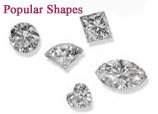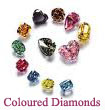Know About Diamonds
Jewelry is special. It lasts a lifetime. It has always been an emotional and sentimental experience that evokes wonderful memories while still giving pleasure for years ahead. When buying for yourself or for others, one has to have an understanding of the qualities and characteristics of jewelry, which is why Surat Diamond has put forth this article.
Thinking about buying a diamond?
If you are thinking of buying a diamond, you are about to enter an enchanting world of romance, intrigue, legend and history. It is said that the Cupid’s arrows were tipped with diamonds. The Ancient Greeks believed that diamonds were pieces of stars that fell to earth and some said they were the tears of God. Diamonds have been sought after, fought over and even worshiped, hence they have become the ultimate gift of life.
Why a diamond?
The reasons for buying Diamonds are as diverse as the people who desire them.
- Diamonds are beautiful:Formed millions of years ago, they have stood the test of time with a fire and brilliance that is unquenchable. They create an aura of success and inspire feelings of pride.
- Diamonds are durable: A diamond is the hardest substance known. They resist deterioration and you can be confident that the diamond you buy today will still shine as brilliantly when your great-grandchildren wear it.
- Diamonds are Rare: For every carat of rough diamonds recovered, more than 250 tones of ore is blasted, crushed and processed. Only 20% are of gem quality.
Choosing a diamond:
Two diamonds may at first glance look alike, but the truth is that they are very different. Although they may be of equal size, they may have very unequal values.
A Diamond has four characteristics, known as the 4 C’s – Cut, Colour, Clarity and Carat Weight. These 4 C’s will help you understand while buying a Diamond. It is the combination of these four factors that determines the value of a Diamond.
 Cut: The quality of the cut determines the brilliance of a Diamond. It is the skill of the cutter that unlocks the natural beauty of a diamond, revealing all of its hidden fire and brilliance. Most Diamonds are cut with full 58 facets and it is important that these are cut to precise angles. A diamond that is cut well reflects light from one facet to another and then back out through the top of the diamond. Only a well cut diamond will really sparkle.
Cut: The quality of the cut determines the brilliance of a Diamond. It is the skill of the cutter that unlocks the natural beauty of a diamond, revealing all of its hidden fire and brilliance. Most Diamonds are cut with full 58 facets and it is important that these are cut to precise angles. A diamond that is cut well reflects light from one facet to another and then back out through the top of the diamond. Only a well cut diamond will really sparkle.
 Colour: Most Diamonds when seen alone appear white, but most have a tint of colour, mainly yellow. Diamonds with no trace of colour at all are extremely rare and the closer they are to no colour, the more rare and valuable they will be. Also rare are diamonds with a strong pure colour that are called “fancies” and which are very valuable.
Colour: Most Diamonds when seen alone appear white, but most have a tint of colour, mainly yellow. Diamonds with no trace of colour at all are extremely rare and the closer they are to no colour, the more rare and valuable they will be. Also rare are diamonds with a strong pure colour that are called “fancies” and which are very valuable.
Clarity: Diamonds were formed millions of years ago, deep within the earth under enormous heat and pressure. Consequently most diamonds contain tiny marks, known as inclusions, which make each stone unique. The inclusions don’t necessarily weaken the stone and when they don’t interfere with the passage of light they do not affect its beauty. The fewer and smaller the inclusions, the more valuable a diamond will be.
Carat weight: Diamond weight is measured in carats, and each carat is divided into 100 points. A carat is equal to one-fifth of a gram. It is the simplest of its characteristics to measure and from the earliest times it was used to calculate a diamond’s value.
Different settings for your diamond:
- Bezel Set: Diamond set in a sleeve of gold, rubbed over al the way around.
- Channel Set: A diamond set in a row with a strip of gold either side to hold the diamonds in place.
- Claw set: A diamond set with each claw bent over to secure the stone.
- Pave/Grain set: Diamonds set close together, held in place with grains of gold.
Treated diamonds:
There are a number of ways in which diamonds can be ‘treated’. Care should be taken when repairing any jewellery containing treated diamonds. If you know the diamonds it treated, tell the jeweler!
- Laser drilled: The drilling literally ‘burns’ out an inclusion. Can sometimes be seen as a fine line or tube.
- Fracture filled: Laser drilled and filled with a ‘ceramic’ type substance close in density to diamond. The filling lessens the ability to see the inclusions. Can sometimes be detected by a faint mauve ‘flash’ under magnification.
- Irradiated: Artificially coloured by electron bombardment. The coloration is permanent and typically includes green, blue and yellow.
How much should One spend on a Diamond Engagement Ring?
All that a diamond engagement ring symbolizes is priceless. But while purchasing one you have to be Sol. Ringpractical. So, how much should one spend on this significant purchase? Today, two month’s salary is generally considered to be a good guideline. Planning a wedding can be an expensive time, but remember that costly receptions and honeymoons quickly become a memory, and fairytale wedding dresses will be worn once and then quickly fade. However a diamond will be with you forever and will be a constant sparkling reflection of your love for each other.
How to care for your diamonds and it’s setting:
Diamonds need care to keep them at their brilliant best. A clean diamond reflects light better than one that has been dulled by skin oil, soap, cosmetics and grease. So it is important to clean your diamonds regularly. It is also possible to clean your diamonds at home with commercial jewelry cleaners and a mixture of ammonia, detergent and warm water. Soak the diamond in the solution (the dirtier it is the longer it will need) and then scrub gently with a soft brush. Making sure the plug is in the sink, rinse well with water, and dry with a soft lint-free cloth.
Do not wear your diamond ring while doing rough work and don’t let your diamond jewelry come into contact with chemicals as the setting may pit or discolour. It is advisable to take you jewelry for a professional clean and polish every year.